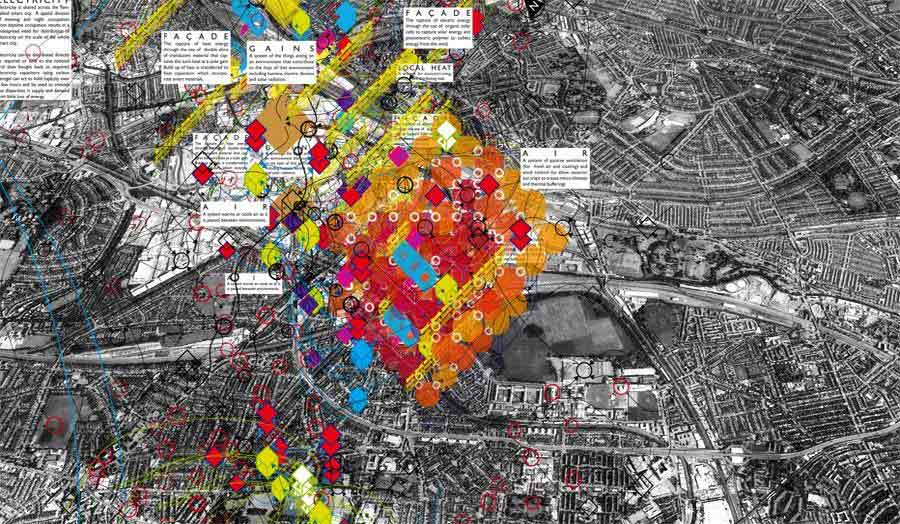Unit Brief
Smart London
Project:
The design of a Smart City District and prototype architecture for the redevelopment of the Old Oak Common area, West London, surrounding the planned interchange between the HS2 and Crossrail 2 rail networks. HS2 is the proposed scheme that is to connect London with Birmingham and later Glasgow by means of a high speed railway line. Part of this scheme is the construction of a new transport hub in the Old Oak Common area, a largely brownfield site twice the size of the King’s Cross development area that is situated on the border between the boroughs of Hammersmith and Fulham, Brent and Ealing, and thus in one of Britain’s best-connected locations. At the moment of writing it is not certain if this project will go ahead. But whatever happens we intend to use this plan as a case project of new infrastructure being a catalyst for urban innovation.
The unit will continue its work of recent years (2010 Thames Gateway (UK), 2011 Smart City Royal Docks (London), 2012 Smart City Tempelhof (Berlin)), researching the emerging phenomenon of Smart Cities through a series of didactic modelling tasks and collaborative workshops, then applying this research to the design of a Smart City District on the site of the Old Oak Common in north-west London. Students will be expected to address all scales, from national impacts, masterplanning and building design, down to innovation in materials and building construction details. The unit's research and design developments will be carried out in close cooperation with HS2, local planning authorities in London, international Smart City experts, and the Technical University Berlin in Germany.
Timeline:
The year will be divided into two parts:
1. Analysis and modelling of global issues and forces, introducing topological concepts and spatial diagramming. Modelling of hybrid materials and technologies related to urban design and architecture, using digital manufacturing techniques, eg 3D printing. This will take the form of the Sphere and Cube exercise, developed in cooperation with MetWorks, following the success of the public exhibition in Whitechapel of the year 2011/2012. This exercise links a wider cosmological approach to Smart City development to the need for innovation in potentially global building systems. The unit will look into the theoretical background of these issues through a variety of texts and websites.
2. Design work for a Smart City District and related prototype architecture in the Old Oak Common area, London. Here students will work on the development of architectural methodologies, design and urban design for this area. We will take the Mayor’s plans as the basis of the design but students will be asked to reinterpret these plans and come up with new ideas.
Part 1 will build up the theoretical and technical expertise that is needed for the design task in part 2. Although there is no restriction to students' working methods, we are able to offer assistance in the learning of software.
Workshops and Excursions:
1. November 2013: Excursion to Berlin, Germany, including a week-long design workshop with students of the Technical University Berlin and the University of Innsbruck, Austria, focusing on mass production in architecture. This excursion will also include visits to urban and architectural projects in Berlin.
2. March 2014: Joint workshop with students of the TU Berlin on the Old Oak Common site, testing out concepts and strategies for a Smart City District.
Background Context:
The world’s urban areas are increasingly being subjected to the impact of two major global transformations: Climate Change, and the emerging, deep control of materials and their flows – the internet of things.
The first presents a concrete danger: our atmosphere will heat up dramatically and the only way humanity can respond is by reducing its use of fossil fuels that cause the greenhouse gases responsible for climate change. This dramatic development is part of a global transformation so profound as to be named in geological terms the ‘Anthropocene’ – a permanent change in the skin of the earth caused by human behaviour. While this development may in turn lead to another danger – the adoption in both urbanism and architecture of dogmatic ‘solutions’ to problems not yet fully understandable – the second transformation presents an opportunity. Changes in industrial and technological development and transdisciplinary research are leading to a new generation of materials and architectural elements that can interact with environmental changes, and to a new phase of the internet that enhances the communication between systems and things or matter.
Architecture is directly affected by these advances in materials and production. Mass production of more energy-efficient, but also cost-efficient, architectural components may become a big issue once more, especially for those countries with growing populations and scarce resources. And transformations in infrastructure, such as for energy, mobility, communication, will lead to a new urban intelligence, the so-called ‘Smart City’. The Smart City has two goals: to integrate industrial innovation with economic, social, cultural and political conditions, and to help society mitigate and adapt to the effects of Climate Change.
Within the conceptual framework of the Smart City the unit will investigate which forms of urbanism and which architectural methodology and aesthetic could emerge from the confluence of major global changes, and investigate and propose urban projects and prototype architectures.

Details
| Course | Professional Diploma in Architecture - RIBA Part 2 |
|---|---|
| Tutors | Raoul Bunschoten Dirk Lellau Henry Jones |
| Website | chora.tu-berlin.de (defunct) facebook.com/contact.chora |
